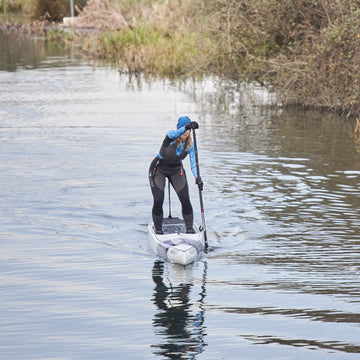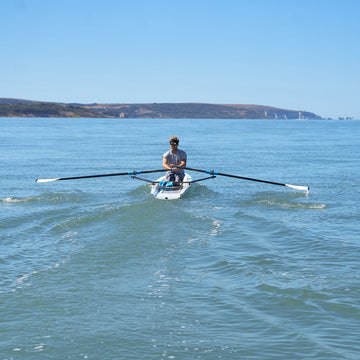In the Streaker we have a rig that is a halfway house between an un stayed rig and a stayed rig with spreaders. With no spreaders to deflect or control the mast, the mast bend will depend on your settings of shroud and forestay and how much you are going to let the deck support your mast. I like to set up the rig so that the boom is parallel if not closing on the aft deck when sailing to windward in 12 knots with lots of sheet or vang tension. You should also note that your mast will behave differently when you are hanging out over the side of the boat in maximum power conditions, when compared to someone 3 stone heavier. If you are lighter then you will need a more forgiving set up to allow your mast to yield and give you acceleration. So I rarely share numbers to un-stayed rig sailors, instead I offer the following tips: Less than 5 knots. Beating. There is no difference in the set up here whether you are light, heavy, fit or unfit; unless you are expecting the wind to increase through the race. Primarily you will need to take out the bag of the sail near the mast - sail makers call this luff curve which is very useful when the wind gets up some more. But now in these drifter conditions, going to windward, this early bag in the sail shape is not desirable. Sheeting hard to take out the luff curve or sail cloth near the mast will hook the leach which is also not desirable. Ideally we would like to sheet with relatively light tension, paying particular attention to the top tell tail. Try to keep it just flying. But we still have the excess luff curve to manage.
Managing the luff curve: 1. Pull on the outhaul - this sucks a little luff curve out of the sail. 2. Release the in-haul of the sail which can fool the sail that there is lots of low down mast bend - which again reduces the excess luff curve situation and allows you to get the wind to stick to the sail early on its journey across the sail. 3. Over release the Cunningham tension - or even halyard tension and encourage some small horizontal creases I your sail. This will help you take the draft aft (this is the reverse of Cunningham which pulls the draft forward) 4. If you are sure that the conditions will not change - you might consider easing the forestay which will allow the mast to bend more with the weight of the sail. However, if the wind increases by 5 knots you might regret this as you would quickly run out of power and luff curve.
8-12 Knots - BeatingMy basic rule is sail in 12 knots of breeze - if you are struggling for power and pointing ability - pull on the forestay tension - if you have too much power - then let the forestay off a bit.Now - in the higher gusts you can start to really work the wind - and suck out plenty of power using your leach. I use relatively tight forestay and slack shrouds. I use main sheet tension to gain the most power from the rig - as using the vang (often used by sailors to help take out the luff curve) unfortunately depowers the mast as it pushes the boom into the mast. This wind strength is often the transition between vang sheeting (if you have too much luff curve to remove with normal cheats above) and mainsheet sheeting which develops lots of power in the rig. A constant eye on the leach tell tails to ensure they are still breathing in the gusts whilst also being aware that too much tension can over flatten the sail and stall the tell tails. Constant sheet tension changing is required. 12 knots to 15 knots - Beating
 Note: Ian Jones leeward shroud tension.
Note: Ian Jones leeward shroud tension. Rig Set up in 12 - 15 Knots. (note closing on the aft deck) Mainsheet tension to help maintain height with some vang tension that holds the leach if I ease the sheet.
Rig Set up in 12 - 15 Knots. (note closing on the aft deck) Mainsheet tension to help maintain height with some vang tension that holds the leach if I ease the sheet.



















 Select Store
Select Store
 EU
EU
 US
US
